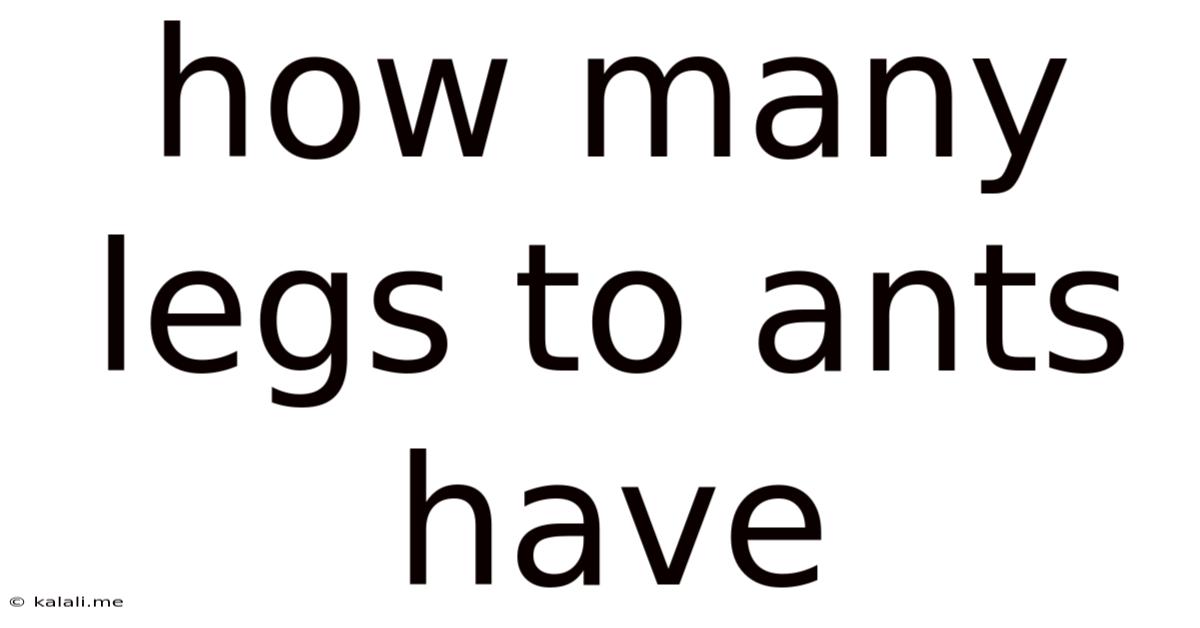How Many Legs To Ants Have
Kalali
Jun 13, 2025 · 3 min read

Table of Contents
How Many Legs Do Ants Have? A Deep Dive into Ant Anatomy
Meta Description: Discover the fascinating world of ants and learn exactly how many legs they possess. This article delves into ant anatomy, exploring their leg structure and function, and comparing them to other insects. Learn about the incredible strength and adaptability of these tiny creatures.
Ants are ubiquitous insects, found across the globe in diverse habitats. Their tireless work ethic and complex social structures have fascinated scientists and nature enthusiasts for centuries. But have you ever stopped to consider the basic anatomy of these tiny creatures? A common question that arises is: how many legs do ants have? The simple answer is six.
Understanding Ant Anatomy: Legs and More
Like all insects, ants belong to the class Insecta, characterized by their three-body segments: the head, thorax, and abdomen. Crucially, it's the thorax, the middle segment, that bears the six legs. Each leg is composed of several segments: the coxa, trochanter, femur, tibia, and tarsus, culminating in claws that help them grip surfaces.
This six-legged design is incredibly efficient. It allows ants to navigate complex terrains, climb vertical surfaces, and even carry objects many times their own weight. Their legs are incredibly strong and adaptable, contributing to their success as a species.
The Role of Ant Legs: More Than Just Walking
Ant legs aren't just for walking; they serve multiple vital functions:
- Walking and Running: The primary function, enabling ants to explore their environment and travel between foraging sites and the nest. Their speed and agility are surprising considering their size.
- Climbing: Specialized structures on their legs, such as claws and adhesive pads, allow ants to climb almost any surface, including smooth vertical walls and even upside down.
- Jumping (in some species): While not all ants jump, certain species have evolved powerful legs capable of propelling them short distances.
- Sensory Reception: Ant legs contain sensory organs called sensilla, which help detect chemical cues, vibrations, and other environmental stimuli.
- Carrying Objects: Ants' remarkable strength allows them to carry objects far exceeding their own weight. This is partly due to the robust structure of their legs.
- Cleaning: Ants use their legs to clean their antennae and bodies, keeping themselves free from debris and parasites.
Comparing Ants to Other Insects
While the six-leg structure is common to all insects, the specific adaptations of ant legs differ from those of other insects. For example, while a grasshopper might use its powerful hind legs for jumping, ants rely on a coordinated movement of all six legs for both locomotion and load-bearing. This highlights the unique evolutionary adaptations found within different insect groups. Bees, flies, and beetles – all also possess six legs, demonstrating a consistent characteristic of the insect class.
Conclusion: The Six-Legged Wonders of the Insect World
The simple answer to “How many legs do ants have?” remains six. However, understanding the intricacies of ant leg anatomy reveals a far more complex and fascinating picture. The incredible strength, adaptability, and multi-functional nature of these six legs contribute significantly to the remarkable success of ants as a globally dominant group of insects. Their ability to thrive in diverse environments is a testament to the elegance and efficiency of their evolutionary design.
Latest Posts
Latest Posts
-
How Many Cups In 12 Oz Chocolate Chips
Jul 01, 2025
-
Did Bill And Gloria Gaither Lose A Child
Jul 01, 2025
-
How Old Are You If Your Born In 1988
Jul 01, 2025
-
How Many Quarts Are In 18 Gallons
Jul 01, 2025
-
How Old Are You If You Were Born In 2002
Jul 01, 2025
Related Post
Thank you for visiting our website which covers about How Many Legs To Ants Have . We hope the information provided has been useful to you. Feel free to contact us if you have any questions or need further assistance. See you next time and don't miss to bookmark.